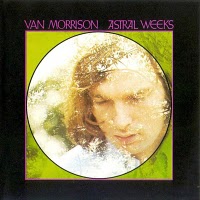 “If I ventured in the slipstream, between the viaducts of your dream…” and so opens the poetic dream masterpiece, Van Morrison’s “Astral Weeks.” It’s one of those monuments to human emotion that has the power to carry the weight of your life with it. The funny thing is, I really wasn’t feeling Van for the longest time, always shelving him away in the “mom-rock” bin. Then all of a sudden something hit me and quickly snowballed into the realization of his genius. With Astral I find the strength lies in the fact that, although the production is both classical and traditional in instrumentation, the record comes across as highly psychedelic from the mysticism of the arrangements. It’s similar in that way to the first few Leonard Cohen records or Townes Van Zandt’s “Our Mother the Mountain,” And for being such a contender among quality poetic-psyche LP’s, it’s easily available and usually pretty cheap, so there’s no reason why you can’t check it out. –Alex
“If I ventured in the slipstream, between the viaducts of your dream…” and so opens the poetic dream masterpiece, Van Morrison’s “Astral Weeks.” It’s one of those monuments to human emotion that has the power to carry the weight of your life with it. The funny thing is, I really wasn’t feeling Van for the longest time, always shelving him away in the “mom-rock” bin. Then all of a sudden something hit me and quickly snowballed into the realization of his genius. With Astral I find the strength lies in the fact that, although the production is both classical and traditional in instrumentation, the record comes across as highly psychedelic from the mysticism of the arrangements. It’s similar in that way to the first few Leonard Cohen records or Townes Van Zandt’s “Our Mother the Mountain,” And for being such a contender among quality poetic-psyche LP’s, it’s easily available and usually pretty cheap, so there’s no reason why you can’t check it out. –Alex
Album Reviews
Charles Wright and the Watts 103rd St. Rhythm Band “Express Yourself” (1970)
 Somewhere between the funk formalism of James Brown and free-spiritedness of Sly Stone can be found Charles Wright. In a perfect world, this enormous talent would be mentioned in the same breath as Redding, Gaye, and Green, but Wright’s long-term success was hobbled by the line-up changes of his various backing bands, inconsistent records, and other music biz unpleasantries. Though he recorded lots of great music–even his weakest efforts are at least worth hearing–this record is his best. Its title track is its most famous (and most sampled), but other tracks like “I Got Love” and the free-form funk freakout, “High as Apple Pie parts 1 & 2”, give it a gospel-like sense of joy. Few reissued records have caused as much confusion as this one. The original release kicked off with a tight little number called “A Road Without End”. Future pressings, however, replaced that track with “Love Land”, which appeared on his previous LP, In the Jungle Babe. “Love Land” is a great song in its own right, but it doesn’t suit the feel of Express Yourself as well as the track it replaces. For this reason, an original pressing of the record is well-worth tracking down. –Richard P
Somewhere between the funk formalism of James Brown and free-spiritedness of Sly Stone can be found Charles Wright. In a perfect world, this enormous talent would be mentioned in the same breath as Redding, Gaye, and Green, but Wright’s long-term success was hobbled by the line-up changes of his various backing bands, inconsistent records, and other music biz unpleasantries. Though he recorded lots of great music–even his weakest efforts are at least worth hearing–this record is his best. Its title track is its most famous (and most sampled), but other tracks like “I Got Love” and the free-form funk freakout, “High as Apple Pie parts 1 & 2”, give it a gospel-like sense of joy. Few reissued records have caused as much confusion as this one. The original release kicked off with a tight little number called “A Road Without End”. Future pressings, however, replaced that track with “Love Land”, which appeared on his previous LP, In the Jungle Babe. “Love Land” is a great song in its own right, but it doesn’t suit the feel of Express Yourself as well as the track it replaces. For this reason, an original pressing of the record is well-worth tracking down. –Richard P
Back “Sea Change” (2002)
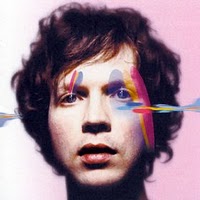 Covering The Zombies, John Martyn, and Nick Drake during his sessions and tour of Sea change, Beck’s influences are ly heard and channeled this time around. While Mutations was all over the place, here Beck works on a very focused playing ground yet stretching some songs to the limit like the bare “Paper Tiger” or very solemn “It’s All in Your Mind”. His voice reaches such a level of power and beauty that could never have been foreseen coming from Mr.MTV Makes Me Wanna Smoke Crack, especially in the country tinged “Guess I’m Doing Fine”. There is just such a chilling yet peaceful tone to Beck’s voice and overall melodies that fully captures what the man must’ve felt to put out such an unpredictable yet honest record.
Covering The Zombies, John Martyn, and Nick Drake during his sessions and tour of Sea change, Beck’s influences are ly heard and channeled this time around. While Mutations was all over the place, here Beck works on a very focused playing ground yet stretching some songs to the limit like the bare “Paper Tiger” or very solemn “It’s All in Your Mind”. His voice reaches such a level of power and beauty that could never have been foreseen coming from Mr.MTV Makes Me Wanna Smoke Crack, especially in the country tinged “Guess I’m Doing Fine”. There is just such a chilling yet peaceful tone to Beck’s voice and overall melodies that fully captures what the man must’ve felt to put out such an unpredictable yet honest record.
Beck has always channeled his place in life and views throughout his albums, whether people could see it through his bizzare language and theatrics is something less debatable. Mutations was his Moon & Antarctica (read: Hopeless, disenchanted sad sack record) but you would have never known, but here we see the most straightforward lyricism yet from Beck. The bitterness (“Is that what you thought love was for?”), the one sided love (“I can’t cry them anymore/I can’t think of what they’re for”), and hopeful hopelessness (“Let it pass on the side of the road/What a friend could tell me now”); Everything here is easy to read into yet nonetheless powerful or mysterious.
As much of a downer Sea Change was in 2002, it gave me a real sense that Beck went on this sorrowful, soul-draining spiritual journey so I wouldn’t have to. It was quite the opposite but Sea Change turned out to become one of the best friends I’ve had. Life’s turned out to be less of my own private award show of Mr. Holland’s Opus and more of a grim train ride passing by everyone I’ve hurt and everyone that’s failed to see how I’ve helped them. I guess I’m at the “Already Dead” part of my life working up to “Side of the Road”, so it makes sense that the 2nd half of the album has began to click with me. It’s also has begun to make sense how strangely beautiful the most awful moments of your life can be, especially when Sea Change is your soundtrack. –Allistair
Fleetwood Mac “Tusk” (1979)
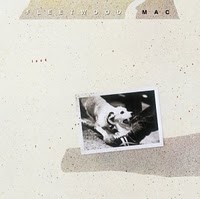 I believe that the true power in this world is love. There’s obviously a strong universal relation to the longing of the soul. I also believe that Fleetwood Mac just might be the best musical representation of love. I could probably write about any Mac record, making similar points, TUSK just happens to be living on my turntable at the moment. It’s not a perfect album by any means, but when you dive deep into this band, it all hits the spot. TUSK is the double-LP follow up to their multi-platinum break up monster, Rumors. Of course there’s no way Tusk could ever have been nearly as much of a commercial success, but that’s what’s nice about it for me, there’s at least one full-length records worth of killer pop “anti” hits that still satisfy the listener in the same way, beautiful vocal coloring over lindsey buckingham’s percussive strumming and driven home by that wonderful snare crack that mick fleetwood perfected in the pop years. Plus this seems to be the point where Buckingham really took over the production and, for lack of a better term, went insane. So the arrangements are wacky as hell at some points and he must have played at least 50 different stringed instruments on it, but what’s love without craziness? Give this a chance if you haven’t already. For lovers only. –Alex
I believe that the true power in this world is love. There’s obviously a strong universal relation to the longing of the soul. I also believe that Fleetwood Mac just might be the best musical representation of love. I could probably write about any Mac record, making similar points, TUSK just happens to be living on my turntable at the moment. It’s not a perfect album by any means, but when you dive deep into this band, it all hits the spot. TUSK is the double-LP follow up to their multi-platinum break up monster, Rumors. Of course there’s no way Tusk could ever have been nearly as much of a commercial success, but that’s what’s nice about it for me, there’s at least one full-length records worth of killer pop “anti” hits that still satisfy the listener in the same way, beautiful vocal coloring over lindsey buckingham’s percussive strumming and driven home by that wonderful snare crack that mick fleetwood perfected in the pop years. Plus this seems to be the point where Buckingham really took over the production and, for lack of a better term, went insane. So the arrangements are wacky as hell at some points and he must have played at least 50 different stringed instruments on it, but what’s love without craziness? Give this a chance if you haven’t already. For lovers only. –Alex
King Crimson “Red” (1974)
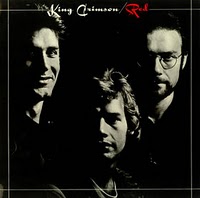 A caged beast of a record, and easily this group’s best, it strips away most of their obscurantist pretensions to serve up a guitar bass and drum assault that runs frequently into the red and is something to behold: Bruford’s drumming is jaw-dropping, while Fripp plays with a dark metallic intensity that suggests he’s one of rock’s wasted talents. I can even put up with John Wetton here, whose ferocious bass playing is more like a second (maybe third) lead instrument and whose singing has a kind of macho bravura that suits this music’s seething intensity. Still, the beast is caged. I’m always a little let down by the second side, which is what keeps Red from essentially essential status, with the wandering “Providence” (another crack at the improv-based excursions heard on the previous album) and the somewhat undercooked “Starless.” No, I’m not kidding: “Starless,” which many listeners seem to think is a masterpiece, could’ve used a little more work. I’m forever disappointed by the whole trajectory of this track, which at 12-some minutes would’ve benefited from a few more (the majestic ending should’ve been lengthier, to provide a kind of bookend equivalent to the sturm-und-drang of “Red;” it may be quibbling, but it’s my party and I’ll cry if I want to). So, instead of the Godzilla of prog-rock tracks, “Starless” is merely a woolly mammoth. This group never made the great record they should’ve made. This one’s the only one that comes close. And oh so close. –Will
A caged beast of a record, and easily this group’s best, it strips away most of their obscurantist pretensions to serve up a guitar bass and drum assault that runs frequently into the red and is something to behold: Bruford’s drumming is jaw-dropping, while Fripp plays with a dark metallic intensity that suggests he’s one of rock’s wasted talents. I can even put up with John Wetton here, whose ferocious bass playing is more like a second (maybe third) lead instrument and whose singing has a kind of macho bravura that suits this music’s seething intensity. Still, the beast is caged. I’m always a little let down by the second side, which is what keeps Red from essentially essential status, with the wandering “Providence” (another crack at the improv-based excursions heard on the previous album) and the somewhat undercooked “Starless.” No, I’m not kidding: “Starless,” which many listeners seem to think is a masterpiece, could’ve used a little more work. I’m forever disappointed by the whole trajectory of this track, which at 12-some minutes would’ve benefited from a few more (the majestic ending should’ve been lengthier, to provide a kind of bookend equivalent to the sturm-und-drang of “Red;” it may be quibbling, but it’s my party and I’ll cry if I want to). So, instead of the Godzilla of prog-rock tracks, “Starless” is merely a woolly mammoth. This group never made the great record they should’ve made. This one’s the only one that comes close. And oh so close. –Will
Go-Go’s “Beauty and the Beat” (1981)
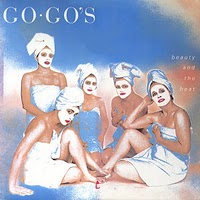 Much as the Rock press would like to think, The Go-Go’s were never Punk Rock. What they did take from Punk was the ethos rather than the music, the ability to form a band from a group of like minded individuals who perform music, disregarding technical musical ability or preconceived notion that rock is a masculine world, and for a brief moment they were the Darlings of the music industry. “Beauty And The Beat” is a testament to this ethic, brash, fun, slightly shambolic, but always heartfelt Power Pop. Formed in 1978 and originally called The Misfits and made up of Belinda Carlisle (Vocals), Jane Wiedlin (Guitar, Vocals), Charlotte Caffey (Guitar, Vocals), Margot Olaverra (Bass), and Elissa Bello (Drums), the band’s major breakthrough would come through building a following from their support slot for British Ska nutty boys, Madness, and this led to a contract with Stiff Records for a one off single “We Got The Beat”. The major record labels showed an interest in both the single and the live following the band were attracting, and The Go-Go’s signed to IRS in early 1981. This, their debut would reach number 1 in the Billboard album charts for 6 weeks and would eventually go to sell over 2 million copies. Spiky Power Pop at its best, the Jane Wiedlin/Terry Hall co-composed single “Our Lips Are Sealed” would be the star attraction, along with other highlights including “We Got The Beat”, “This Town”, “Lust To Love”, and the fine closer “Can’t Stop The World”. A surprisingly assured album, that carries alongside its demure directness, a touching astuteness. –Ben H
Much as the Rock press would like to think, The Go-Go’s were never Punk Rock. What they did take from Punk was the ethos rather than the music, the ability to form a band from a group of like minded individuals who perform music, disregarding technical musical ability or preconceived notion that rock is a masculine world, and for a brief moment they were the Darlings of the music industry. “Beauty And The Beat” is a testament to this ethic, brash, fun, slightly shambolic, but always heartfelt Power Pop. Formed in 1978 and originally called The Misfits and made up of Belinda Carlisle (Vocals), Jane Wiedlin (Guitar, Vocals), Charlotte Caffey (Guitar, Vocals), Margot Olaverra (Bass), and Elissa Bello (Drums), the band’s major breakthrough would come through building a following from their support slot for British Ska nutty boys, Madness, and this led to a contract with Stiff Records for a one off single “We Got The Beat”. The major record labels showed an interest in both the single and the live following the band were attracting, and The Go-Go’s signed to IRS in early 1981. This, their debut would reach number 1 in the Billboard album charts for 6 weeks and would eventually go to sell over 2 million copies. Spiky Power Pop at its best, the Jane Wiedlin/Terry Hall co-composed single “Our Lips Are Sealed” would be the star attraction, along with other highlights including “We Got The Beat”, “This Town”, “Lust To Love”, and the fine closer “Can’t Stop The World”. A surprisingly assured album, that carries alongside its demure directness, a touching astuteness. –Ben H
Tim Buckley “Starsailor” (1970)
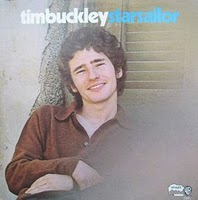 Tim Buckley had already begun to alienate his folkie fanbase with “Lorca” a few months earlier– what the hell was up with this golden-voiced disciple of Fred Neil? Why would he release an album filled with meandering free jazz-like structures and vocal gymnastics that made it sound as though he was being disemboweled? Well, if they wuz bewildered by “Lorca,” “Starsailor” musta felt like a kick in the groin. Not only was it a continuation of the avant garde themes which in hindsight, he’d barely scratched, it was a full-on operetta revolving around the pit of anguish that burned in his guts; he also began to fully utilize the five and a half octave vocal range he had at his disposal.
Tim Buckley had already begun to alienate his folkie fanbase with “Lorca” a few months earlier– what the hell was up with this golden-voiced disciple of Fred Neil? Why would he release an album filled with meandering free jazz-like structures and vocal gymnastics that made it sound as though he was being disemboweled? Well, if they wuz bewildered by “Lorca,” “Starsailor” musta felt like a kick in the groin. Not only was it a continuation of the avant garde themes which in hindsight, he’d barely scratched, it was a full-on operetta revolving around the pit of anguish that burned in his guts; he also began to fully utilize the five and a half octave vocal range he had at his disposal.
I’m gonna hazard a guess that Buckley had been listening intently to Leon Thomas– particularly his work with Pharaoh Sanders on “Karma.” He liberally borrows Thomas’ conventional-croon-to-absurd-yodel on several tracks, most notably “Monterey,” a dissonant Voodoo Blues that conjures a vibe equal parts atavistic ritual and sleazy mating call. Bunk Gardner, late of the Mothers of Invention, provides some Ornette-esque sax squawk, further pushing the song into uncharted territory– at least for the early 1970’s zeitgeist. “Moulin Rouge” is a brief slice of Franco-Pop that coulda easily been recorded by Edith Piaf– I only mention it as it is one of the few cuts that provides a respite from the suffocating melancholy and bordering on psychedelic experimentation that makes up the rest of the LP. For instance, the ethereal title track is akin to smoking far too much DMT, only to discover that instead of encountering the promised elves hiding in the artificial netherworld, you find yourself surrounded by bloodthirsty, shapeless abominations far outside the realms of HP Lovecraft’s worst nightmares. Lee Underwood’s stellar guitar work also deserves a nod. His connection with Buckley borders on preternatural– be it the spare, mournful licks he uses to accompany Tim’s wounded wail on the oft-covered/butchered “Song to the Siren,” or the majestic, fleet-fingered riffs that double Buckley’s vocal on “Come Here Woman.”
If you’re new to the elder Buckley, this may not be the best place to start. I’d recommend “Dream Letter: Live in London” for virgins, as well as for fans of his offspring, a certain Jeff. –Jake P
Mercyful Fate “Melissa” (1983)
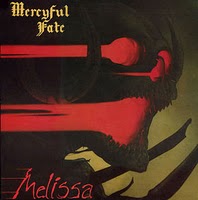 Melissa unleashed the dark majesty of Mercyful Fate on welcoming hordes of eager metalheads ready to set sail on a lake of fire, the band picking up where Priest left off with their late 70’s platters of pain and injecting an elevated sophistication and malevolence embodied in the angelic blasphemor wails of King Diamond. While the edge of Melissa’s sacrifical blade is slightly dulled by the tangled fortress “Satan’s Fall” on side two, the purity of purpose in classics like “Evil,” grave robbing “Curse of the Pharaohs,” and the pummeling “Black Funeral” let loose such torrents of spectral ferocity and hell-spawned riffage that Melissa stands as an all-consuming plethora of wicked delights. –Ben
Melissa unleashed the dark majesty of Mercyful Fate on welcoming hordes of eager metalheads ready to set sail on a lake of fire, the band picking up where Priest left off with their late 70’s platters of pain and injecting an elevated sophistication and malevolence embodied in the angelic blasphemor wails of King Diamond. While the edge of Melissa’s sacrifical blade is slightly dulled by the tangled fortress “Satan’s Fall” on side two, the purity of purpose in classics like “Evil,” grave robbing “Curse of the Pharaohs,” and the pummeling “Black Funeral” let loose such torrents of spectral ferocity and hell-spawned riffage that Melissa stands as an all-consuming plethora of wicked delights. –Ben
Ska and Reggae’s Missing Link:
A Guide to Rocksteady
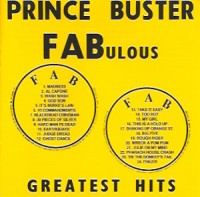
Aside from reggae, ska was arguably Jamaica’s most important musical form, at least in terms of long-term cultural impact. Becoming ubiquitous all over the island at an astonishing speed in the early ’60s, ska grabbed hold of Jamaica’s musical consciousness like nothing had before. What’s more, despite its strange rhythms and heavily-Jamaican-accented vocals (when it wasn’t entirely instrumental), it crossed cultural boundaries almost effortlessly, making it catch on like mad in Britain and—to a lesser degree—the states.
Many Jamaican artists who eventually became international household names, among them Bob Marley and Jimmy Cliff, cut their teeth as performers during ska’s reign. In 1964, Millie Small scored an international smash hit with her skanked-up cover of “My Boy Lollipop”, and soon ska was everywhere. But by 1966, it was mysteriously vanishing in one place: Jamaica. A visit to a typical Kingston dance hall around that time would reveal that things were changing. Ska was becoming more melodic, more centered on the vocalist(s), and slower. Nobody knows for sure why this happened, but there are some theories. One suggests that during the summer of ’66, a brutal heatwave gripped Jamaica, forcing the musicians to slow things down on the dance floor so revelers wouldn’t collapse from heat exhaustion. Another postulates that the increasingly widespread availability of American soul records might have been a factor. (This would certainly make sense, as Stax and Motown influences can be heard all over the place on many Jamaican sides that were cut around this time.)
Whatever the cause, ska was metamorphosing into something completely different, so much so that it needed a new name; rocksteady seems to be the one that stuck. Rocksteady’s heyday was even more short-lived than its predecessor—-really only about two years-—and by the end of 1968, things were changing again. Recording technologies on the island were improving. Rastafarianism’s influence continued to spread, prompting a more socially conscious and politically-charged aesthetic. By the end of the decade, rocksteady was no longer, and reggae prevailed. But for many connoisseurs of modern Jamaican music, rocksteady represents its high point. It’s a form that’s rich and complex, yet raw, pure, and deeply soulful. It’s a truly unique product of its place and time, but one that transcends geography and culture, and which remains timeless. Here are five shining examples.
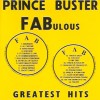 1. Prince Buster: Fabulous Greatest Hits (1980) – Though acquiring a popularity in the UK that at its peak rivaled the Beatles’s, Prince Buster never really established a large following in the US. Tracking down his one uneven RCA release from 1967 is a worthwhile endeavor, but this 1980 British comp is where all newcomers should start. All songs here were recorded in the mid to late ’60s, and many of them would serve as the blueprint for the 2 Tone movement that swept the UK a decade or so later.
1. Prince Buster: Fabulous Greatest Hits (1980) – Though acquiring a popularity in the UK that at its peak rivaled the Beatles’s, Prince Buster never really established a large following in the US. Tracking down his one uneven RCA release from 1967 is a worthwhile endeavor, but this 1980 British comp is where all newcomers should start. All songs here were recorded in the mid to late ’60s, and many of them would serve as the blueprint for the 2 Tone movement that swept the UK a decade or so later.
 2. Desmond Dekker and the Aces Israelites (1969) “The Jamaican Smokey Robinson’s” single “Israelites” represents the only time when rocksteady cracked the US top 100. When it did, MCA rushed to cobble together this collection of songs, some of which by then were almost two years old. It’s still a fantastic showcase for some of Dekker’s best work. He’s at the top of his game here, and so is his backing band.
2. Desmond Dekker and the Aces Israelites (1969) “The Jamaican Smokey Robinson’s” single “Israelites” represents the only time when rocksteady cracked the US top 100. When it did, MCA rushed to cobble together this collection of songs, some of which by then were almost two years old. It’s still a fantastic showcase for some of Dekker’s best work. He’s at the top of his game here, and so is his backing band.
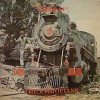 3. The Ethiopians Engine ’54: Let’s Ska and Rocksteady (1968) Rocksteady was the ideal vehicle for the vocal group, and as Jamaican vocal groups went, they didn’t get much better than the Ethiopians. Don’t let the “ska” in the title fool you; most of this is quintessential rocksteady, some of the best ever recorded.
3. The Ethiopians Engine ’54: Let’s Ska and Rocksteady (1968) Rocksteady was the ideal vehicle for the vocal group, and as Jamaican vocal groups went, they didn’t get much better than the Ethiopians. Don’t let the “ska” in the title fool you; most of this is quintessential rocksteady, some of the best ever recorded.
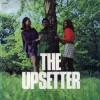 4. The Upsetters The Upsetter (1969) It’s difficult to figure out to whom this album should really be credited. One should know, however, that a young Lee “Scratch” Perry produced it, and whenever this eccentric mastermind is involved, things become, well… complicated. Featuring the work of a cadre of different musicians and vocalists, it’s a surprisingly cohesive late rocksteady record, one where the organ figures more prominently than the work of others at the time. It also hints at the dub revolution, of which Perry would be a prime architect a few years later.
4. The Upsetters The Upsetter (1969) It’s difficult to figure out to whom this album should really be credited. One should know, however, that a young Lee “Scratch” Perry produced it, and whenever this eccentric mastermind is involved, things become, well… complicated. Featuring the work of a cadre of different musicians and vocalists, it’s a surprisingly cohesive late rocksteady record, one where the organ figures more prominently than the work of others at the time. It also hints at the dub revolution, of which Perry would be a prime architect a few years later.
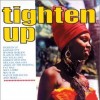 5. Various Artists Tighten Up: Volume 1 (1969) Music from Jamaica continued to capture the hearts and minds of young UK listeners in the late ’60s, but the record industry was slow to profit from its popularity. This Trojan Records “cash-in” comp. spawned a series that would become an institution and number well into the double digits before ending its run. Its first volume defined the musical tastes of the Skinhead movement (before it was co-opted by nationalist and racist thugs). Heavy on soul covers, a few of its tracks denote a distinct progression towards reggae, but most represent some last great moments from Rocksteady’s waning days.
5. Various Artists Tighten Up: Volume 1 (1969) Music from Jamaica continued to capture the hearts and minds of young UK listeners in the late ’60s, but the record industry was slow to profit from its popularity. This Trojan Records “cash-in” comp. spawned a series that would become an institution and number well into the double digits before ending its run. Its first volume defined the musical tastes of the Skinhead movement (before it was co-opted by nationalist and racist thugs). Heavy on soul covers, a few of its tracks denote a distinct progression towards reggae, but most represent some last great moments from Rocksteady’s waning days.
Further listening: Once the digging begins, one will be amazed by how so much great music came from such a small island in such a short period of time. The UK-based Trojan Records label remains the prime importer of rocksteady for a huge portion of the non-Jamaican world. The amount of compilations it has released over the years is overwhelming, but a good place to start is its budget-priced “threefer” box set series that it began churning out at the beginning of the 2000s. The Rocksteady Rarities and Skinhead comps are particular standouts, though there are plenty more (and some are available on vinyl). Also worth mentioning are Soul Jazz Records’ numerous comps that cover this period. Though they touch on other eras, 100% Dynamite and its many sequels and offshoots give a good overview of one of rocksteady’s most important producers, Sir Coxone Dodd. –Richard P
Are we forgetting your favorite rocksteady LP? We’d love to hear your comments:
Phil Manzanera/801 “801 Live” (1976)
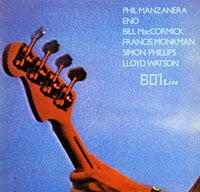 Not your every day live album, 801 Live captures the supergroup featuring ex-Roxy Musicians Phil Manzanera and Brian Eno in one of their few performances. Featuring all the sonic detail, colorful guitar and synthesizer tones, and high-class musicianship you’d expect from such a lineup, another pleasant surprise here is the excellent recording, which almost sounds more like a studio album. A subtle, delicate style informs many of these performances, highlighting tracks from Eno and Manzanera’s early solo albums, the Quiet Sun album, and skewed reworkings of “Tomorrow Never Knows” and “You Really Got Me.” Brainy and electronic, but warm and human as well, 801 Live is an essential purchase for fans of the musicians involved, or seventies art-rock in general. –Ben
Not your every day live album, 801 Live captures the supergroup featuring ex-Roxy Musicians Phil Manzanera and Brian Eno in one of their few performances. Featuring all the sonic detail, colorful guitar and synthesizer tones, and high-class musicianship you’d expect from such a lineup, another pleasant surprise here is the excellent recording, which almost sounds more like a studio album. A subtle, delicate style informs many of these performances, highlighting tracks from Eno and Manzanera’s early solo albums, the Quiet Sun album, and skewed reworkings of “Tomorrow Never Knows” and “You Really Got Me.” Brainy and electronic, but warm and human as well, 801 Live is an essential purchase for fans of the musicians involved, or seventies art-rock in general. –Ben
Joni Mitchell “The Hissing of Summer Lawns” (1975)
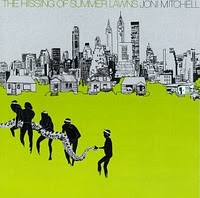 And so, the dazzling beauty of Court and Spark carries on with The Hissing of Summer Lawns. Musically, it continues in a similar vein – an all-star lineup effortlessly shifting between Pop, Folk and Jazz, playing rich, multi-layered arrangements which never overpower Joni, whose main concern is always the song and its words. The lyrics have become more intimate, more melancholic on The Hissing of Summer Lawns and so has the music. Again, one or two songs don’t meet my undivided approval (Shadows and Light and The Jungle Line, even though the song marks the beginning of a lasting Pop format, the attempt to create a multicultural world music, ten years before Peter Gabriel, Sting and others), but the rest is again of celestial beauty. Even Joni, who would go on to record important albums until today, wasn’t able to match the artistic consistency and beauty of Court And Spark and The Hissing of Summer Lawns until many years later, with Turbulent Indigo and Travelogue. –Yofriend
And so, the dazzling beauty of Court and Spark carries on with The Hissing of Summer Lawns. Musically, it continues in a similar vein – an all-star lineup effortlessly shifting between Pop, Folk and Jazz, playing rich, multi-layered arrangements which never overpower Joni, whose main concern is always the song and its words. The lyrics have become more intimate, more melancholic on The Hissing of Summer Lawns and so has the music. Again, one or two songs don’t meet my undivided approval (Shadows and Light and The Jungle Line, even though the song marks the beginning of a lasting Pop format, the attempt to create a multicultural world music, ten years before Peter Gabriel, Sting and others), but the rest is again of celestial beauty. Even Joni, who would go on to record important albums until today, wasn’t able to match the artistic consistency and beauty of Court And Spark and The Hissing of Summer Lawns until many years later, with Turbulent Indigo and Travelogue. –Yofriend
The La’s “The La’s” (1990)
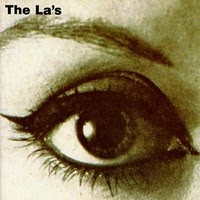 Even though John Power was an essential member of The La’s, I’m loathe to label the band the forerunner of Cast. There are some similarities in the homogeneous nature of the pop music but Power had little to do with writing anything for The La’s. The band was almost the private property of Lee Mavers who, if proof were needed of that fact, took it upon himself to destroy the only copy of the master tapes for the proposed second album because he was dissatisfied with the results. An action which ensured the self-destruction of the band. On the one hand the band’s demise was a cause for pity. The timeless nature of some of the songs, particularly “There She Goes”, hinted at them being around for some time to come. However, on the other hand, the perfectionist disposition of Mavers would probably result in interminable periods of time between albums during which the fickle music fan would have moved on to pastures new. Whilst the songs smack of a long Merseyside tradition for producing enduring pop, Mavers almost hypnotises the listener by repeating the same word or phonetic sounds throughout. The effect lulls you into a trance-like state and the music carries you with it. It really is quite an amazing album and one for which a follow-up would have been eagerly awaited. –Ian
Even though John Power was an essential member of The La’s, I’m loathe to label the band the forerunner of Cast. There are some similarities in the homogeneous nature of the pop music but Power had little to do with writing anything for The La’s. The band was almost the private property of Lee Mavers who, if proof were needed of that fact, took it upon himself to destroy the only copy of the master tapes for the proposed second album because he was dissatisfied with the results. An action which ensured the self-destruction of the band. On the one hand the band’s demise was a cause for pity. The timeless nature of some of the songs, particularly “There She Goes”, hinted at them being around for some time to come. However, on the other hand, the perfectionist disposition of Mavers would probably result in interminable periods of time between albums during which the fickle music fan would have moved on to pastures new. Whilst the songs smack of a long Merseyside tradition for producing enduring pop, Mavers almost hypnotises the listener by repeating the same word or phonetic sounds throughout. The effect lulls you into a trance-like state and the music carries you with it. It really is quite an amazing album and one for which a follow-up would have been eagerly awaited. –Ian


